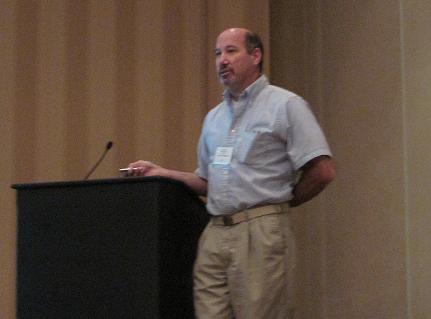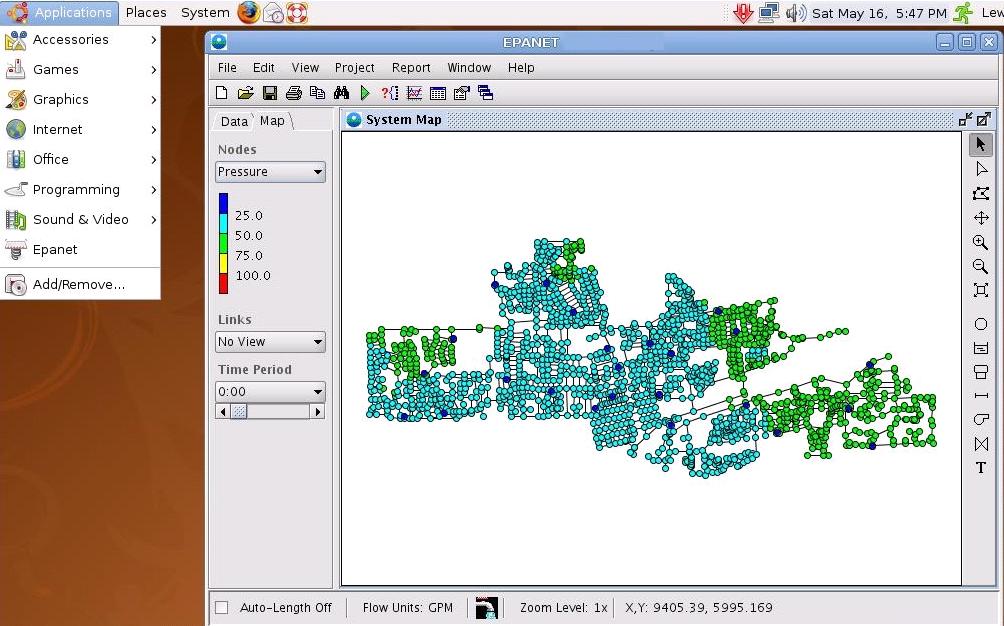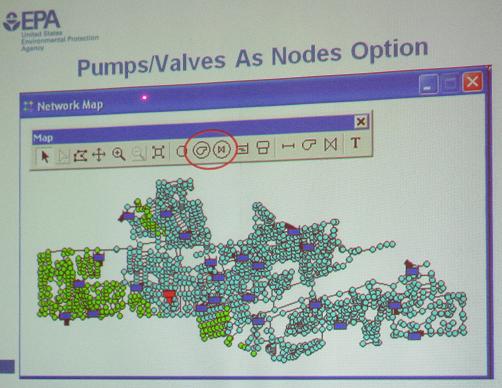EPANet 3
During the WDSA2010 conference, held in Tucson AZ, Lew Rossman gave a sneak peek into the future version of EPANet. It might be called 2.1 or 3.0 and it scheduled to be released probably next year. This will be the last release of EPANet by the US EPA! The following writeup is based on Lew’s paper and presentation.
Enhancements to the computational engine
- The simple Euler scheme used in EPANET 2.0 to update tank levels independently of each other between the time steps of an extended period simulation is being replaced by Todini’s recent extension to the Global Gradient algorithm. This produces a much more stable solution for water levels in hydraulically coupled tanks without having to revert to very small time steps.
- The flow-based convergence criterion used to solve the network hydraulic equations is being replaced by a head-based one. This will provide higher accuracy in satisfying the head loss equation for each pipe once a solution has been found.
- To avoid the hydraulic solution matrix from becoming ill-conditioned when there are zero-flow or low resistance pipes EPANET 3.0 employs the simple regularization scheme suggested by Elhay and Simpson to adjust very low gradients of head loss with respect to flow.
- Two options are being concidered as replacements for the 1980’s vintage sparse matrix solver used in EPANET 2.0.
- A pressure-deficient hydraulic analysis can be run using Todini’s three-stage approach to identify nodes where there is insufficient pressure available to meet required demands and to determine the actual demand that can be delivered at the available pressure. This option avoids the negative pressure results that can sometimes occur when running a standard hydraulic analysis.
- Pressure-dependent demand analysis is being added as another option in EPANET.
- An Altitude control valve (ACV) is being added to the types of control valves that EPANET can model. The “setting” parameter for this type of valve is a user-supplied curve that determines the valve’s head loss coefficient as a function of distance below full depth.
- Cubic polynomials can now be used for pump head and efficiency curves and pump efficiency curves and power calculations can now be scaled for pump speed.
- Users can define both regular and irregular time patterns for altering demands and controlling pumps and valve settings within extended period simulations. Each regular time pattern can have its own time period while irregular patterns can use a set of variable periods that change over time.
Enhancements to the water quality calculations
- The equations developed by Sandia National Laboratories (Ho and O’Rear) that model incomplete mixing at 4-way junctions are being incorporated as an option in EPANET 3.0.
- Longitudinal dispersion of solutes within the bulk flow under laminar flow conditions (Axworthy and Karney) is being added to EPANET’s transport equations. This will necessitate switching the laminar flow pipes from using variable-sized volume segments to uniform-sized ones, reminiscent of the Discrete Volume Element method used back with EPANET 1.1.
- The reaction and transport phases of the water quality computations will be handled using parallel threads to take advantage of the multiple core processors available on today’s personal computers and thus provide a significant computational speed-up. Using parallel threads shows a decrease up to 50% in running time with 8 cores.
- Several additional single species reaction mechanisms are being added to those already contained in EPANET. These include: dissolution reactions, temperature modeling, source-weighted reaction coefficients.
Programmer’s Toolkit
Additional functions are being added to the EPANET 3.0 Programmer’s Toolkit. These include functions that allow one to work with a node’s demand categories, allow one to retrieve the water quality within a link, and determine if a portion of the network is disconnected from any water source or if any two nodes are connected through a path of open links.
Windows graphical user interface
The interface for EPANET 2.0 was written in Delphi. To enable greater access for interested third parties to review and modify the EPANET GUI it was decided to re-write it in a language for which free compilers and other development tools are available. A prototype was written in Java which is platform independent as can be seen in the following image that shows EPANet 3.0 under Ubuntu Linux. C# .NET is also being considered as an option for the GUI.
The EPANET 3.0 GUI will also provide for a linkage with the EPANET multi-species modeling extension. A new option that might be implemented is the option to insert pumps and valves as nodes rather than links. This option will be of interest to those how use GIS data to build hydraulic models.



What a wonderful notice. Congratulations to Mr Rossman and thanks to USEPA. EPANET had been a great tool to design aqueducts in Guatemala and God had blessed us with the no cost of this program against the excesive price of similar programs in the market.
USEPANET and Mr. Rossman had help to the develop of the hydraulic area in Guatemala.
We, at the Universidade Federal do Ceara, in Brazil, developed na interface between AutoCAD and EPANET.
Best regards
Marco Aurelio Holanda de CAstro, PhD
Many thanks for Dr Rossman and for USEPA for the EPANET developements.
Please note that pressurised hydraulic modeling have beeen largely supported by this software in our country, in the public and the private sectors and also in universities. Hendred of models are done and calibrated using EPANET in Tunisia.
I hope that the lats EPANET version will be more flexible and allow best user interaction to add fonctionnalities.
I would like to say thank you for all developer of this program. It help us a lot. I hope EPANet 3 will release soon.
Cheers!
very good
EPANET has been used to design hundreds of rural and urban water supply schemes in Sri Lanka for the last 13 years. The free software helped many engineers and university students to learn network analysis. I use this opportunity to thank USEPANET team and Dr Rossman on behalf of the beneficiaries. Welcome to EPANET 3.0
Interesting! I am doing a research on the effect of water supplying schemes on reliability of water distribution systems. EPANet is the hydraulic simulation software I will be using. It is interesting to note the proposed features of the ‘last’ improved EPANet version. Is there any precise period of time when it would be released for use? I am curious to find out if I could be lucky to have access to the new version. My research period ends in March 2011.
Sorry, there is no official release date that I know of.
It’s good news , I hope epanet3 will release soon .
So this is the end of EPANET development?! After 3.0, EPA will no longer fund future releases? Why? Is there a funding problem?
Even I’m using Epanet2.0 within my research, so far it’s the most accurate software I’ve come across. I’d suggest if possible to make H-W head loss equation more flexible in handling different alpha values. In the literature, some authors use different values from that used in Epanet2.0. For example, Epanet uses a value of 10.67 while some authors used 10.91 or 10.45. In this way, it’s not possible to make fair comparison between results run on Epanet2.0 and other hydraulic models.This could make some researches look for other hydraulic models that use the same alpha value they used in their studies.
In late 2010 I started to look epanet’s programmers toolkit to find a way to simulate programmable controllers. Even though it does not look hard to use epanet for that (as there are functions to retrieve the solution after each time step is ran and also to change settings after each step) I was expecting the third version to make this easy by allowing rules such as (“” arguments don’t work in the current version)
IF PIPE 1 != “PIPE 2 FLOW” AND
PIPE 1 FLOW “IS RISING”
THEN PUMP 1 SETTING “IS REDUCING”
Also, I’m unfamiliar with the Todini’s approach. I used to think the “generated water” by absurd (E-20) negative pressures was somehow a consequence of the numeric algorithm. I might be (and I guess I am) misunderstanding it, but will the new version change the “demand” of a given node to grant positive pressures if the pressure is too low?
I’m looking forward to the releasing! I guess most of this questions will be easily answered with a couple tests. rrsrs
It´s a wonderful notice.
I has been used EPANET for professional aplications and my students at Universidad Tomás Frias used it for learn about
Water Supply.
Tanks Very Much to US EPA.
Alberto Gonzales Murillo
We, at the Federal University of Ceara, developed an interface between AutoCAD and EPANET in order to facilitate input of data (specially topographic and demand data).
If we wish to try please let me know by informing me an e-mail throught wish I can send you web adresses from which you can download the instalation files.
Best regards
Prof. Marco Aurelio Holanda de Castro, PhD
Hello Marco Aurelio, I am very interested in trying your AutoCad interface.
My email is:
jcbobeda@gmail.com
Thank you!
Hello Marco Aurelio, I am very interested in trying your AutoCad interface.
My email is:
kozeka@tut.by
Thank you!
Hello,
does anybody know when if the epanet 3.0 has been already released? …and from where it’s possible to download it? Thanks a lot.
Stan
There is no release date yet 🙁
I have been modeling for 10 years. Our programmers modify EPANET to suit our requirements. Many of the decisions that are being planned in the third version, we have long been using.
Nevertheless it would be interesting to see what’s new will.
very good
Epanet is widely used in my country Venezuela. A new release is of course welcome. I do think that Epanet should be released under an open source licence and so it will grow with the help of worldwide programmers.
We, at the Federal University of Ceara, in Brasil, developed an interface between AutoCAD and EPANET in order to facilitate input of data (specially topographic and demand data).
If we wish to try please let me know by informing me an e-mail throught wish I can send you web adresses from which you can download the instalation files.
Best regards
Prof. Marco Aurelio Holanda de Castro, PhD
Great…..It would support MDG programs better. Thx
dear
please advice when it will be released
Really i worked with EPANET since 3 years and it is wonderfull simulation software.
I used EPANET 2.0 to model a sprinkler Irrigation system and it proved to be a wonderful hydraulic solver.
All that i wish is that the programme can select automatically from a list of commercial pipe sizes during the calculation.for now the designer will have to input the pipe sizes manually and re-run the programme so many times.
I have to say : I want to receive it due to I want to know more about EPANET
hello,
Thanks for the great development work. Some date to the new version?
> it was decided to re-write it in a language for which free compilers and other development tools are available. A prototype was written in Java which is platform independent as can be seen in the following image that shows EPANet 3.0 under Ubuntu Linux. C# .NET is also being considered as an option for the GUI.
They didn’t consider simply finishing the Lazarus port?: http://epanet2lazarus.sourceforge.net/
is it available already?!?
is it already available?!?
Even after too years not yet released? what is happening?
Is EPANET 3 dead? All I can find on it are references that are several years old that promise that it is coming soon. If it is an open source or public domain project, should it not be forked to someone who is interested in actively developing it?
yes, it would be nice to know if Epanet 3 is going to be released. I’m very interested in starting an opensource cross-platform(Win, Linux, Mac OSX) version of the GUI my self.
check out this version for ios: https://itunes.apple.com/us/app/epanet-viewer/id665741309
how can I freely download epanet 3 please
EPANET 3 is not out yet. No release date is available.
EPANET 2.0 FR
Con el EPANET, la relacion B/C tiende a + infinito, Gracias Dr. Rossman.
I’ve been using EPANET for more than 15 years. I’me greatly satisfied. Great thanks to hole team that work on this project.
Automatic pipe selective and optimal design are major challenges to many hydraulic tool, include Epanet. Iam initilly researching ‘sequential Modeling of WDN: Application of Adjancecy Graphical and Pressure Driven Searches”. I hope ll boost up the Epanet tool. Thank to all
EPANET es una gran herramienta para la modelacion de redes hidráulicas. Yo he usado la versión 2.0 y ha sido de gran ayuda para la docencia y la práctica profesional. Dios lo bendiga Dr. Rossman y muchas gracias a la USEPA.
ESPERO QUE PRONTO SALGA LA VERSIÓN 3 DE ESTE MAGNIFICO PROGRAMA DE SIMULACIÓN, PARA PROYECTOS DE DISTRIBUCIÓN Y CONDUCCIÓN DE AGUA ES EL NUMERO 1
Una versión de EPANET que me funcione en w10
EPANET appears to be download-able at:
dofreedownload.com/epanet-3.0-download/
and the cross version java is at least visible at http://epanet.de/js/index.html
As the code is available, why cannot we download a java gui-version to our own pc’s independent of platforms – including android/linux?
seguimos esperando el lanzamiento de Epanet 3…Cuándo..???
DEAR SIR
WE ARE WAITING FOR EPANET 3.0
WHEN IT WILL RELEASE.